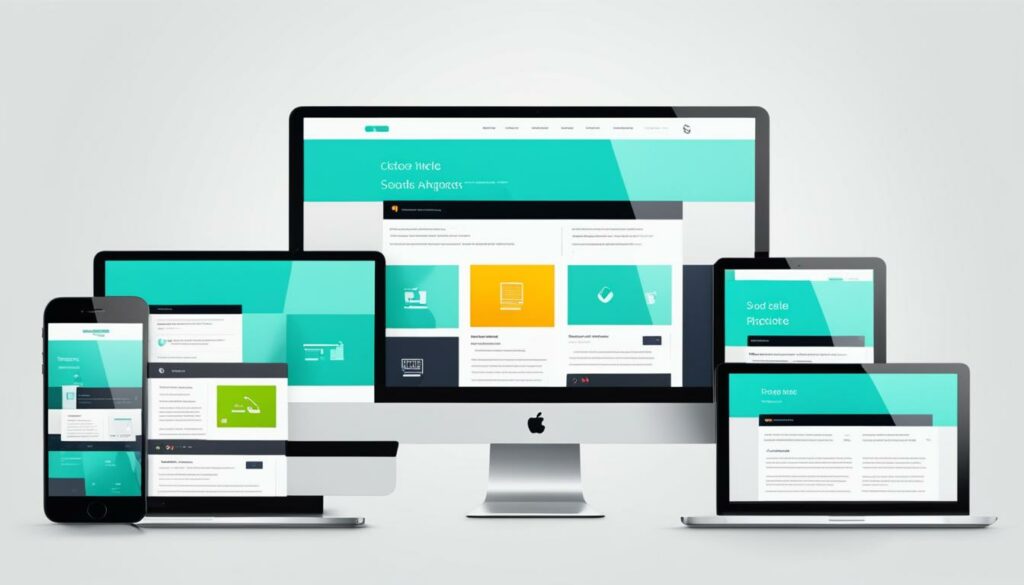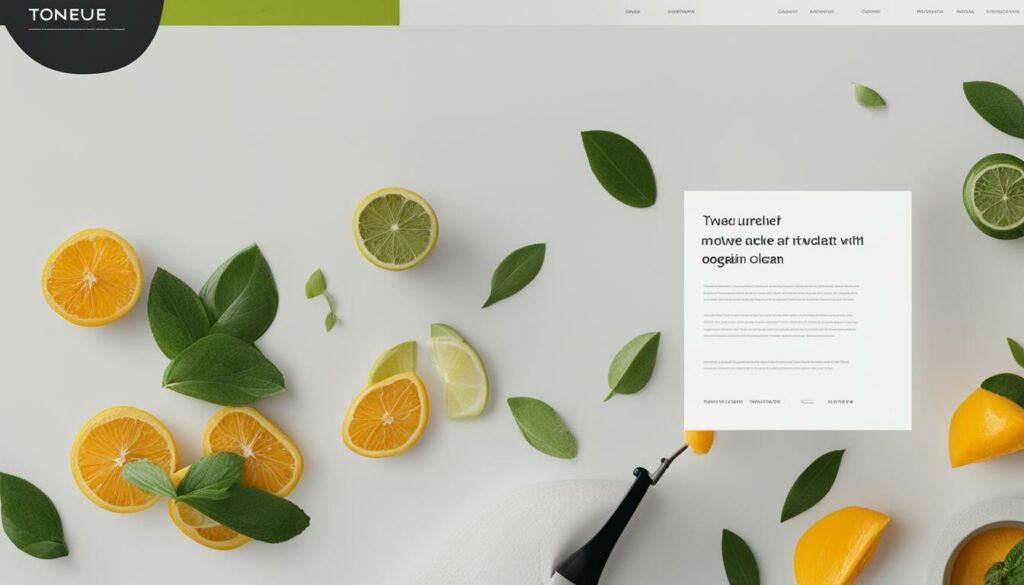When it comes to achieving success with your website, adhering to best practices in web hosting is crucial. Choosing the right web hosting provider and plan can significantly impact your website’s performance, security, and user experience. In this article, we will explore the recommended practices for web hosting based on factual data and expert advice from various sources.
Key Takeaways:
- Choose a reputable web hosting provider that offers reliable services and excellent customer support.
- Consider your website’s requirements and prioritize factors such as security, uptime, and scalability when selecting a hosting plan.
- Optimize your website speed by implementing techniques like image optimization, caching, and utilizing a CDN.
- Regularly monitor your website’s uptime to ensure it is accessible to users and resolve any issues promptly.
- Focus on website security by keeping your website updated, using a web application firewall, and obtaining an SSL certificate.
By following these web hosting best practices, you can create a solid foundation for your website’s success. Now, let’s delve into each practice in detail and equip you with the knowledge to make informed decisions for your web hosting needs.
Choosing the Right Hosting Plan
Selecting the right hosting plan is crucial for the success of your website. With numerous web hosting providers and hosting plans available, it can be overwhelming to make the best choice for your specific needs. To help you navigate through this important decision, we have outlined some key considerations and factors to keep in mind when selecting a hosting plan.
Understanding Your Website Requirements
Before diving into the world of hosting plans, it is essential to understand the specific requirements of your website. Consider factors such as the anticipated traffic volume, storage needs, and the nature of your website (e.g., blog, e-commerce, portfolio). By having a clear understanding of your website’s requirements, you can choose a hosting plan that aligns perfectly with your needs.
Priority on Security, Uptime, and Support
When evaluating hosting plans, prioritize the security features offered by the web hosting provider. Look for features such as strong firewalls, regular backups, and robust encryption protocols to ensure the safety of your data and protect your website from potential threats.
Additionally, consider the uptime guarantee provided by the hosting provider. Uptime refers to the percentage of time your website is accessible to users. Opting for a hosting plan with a high uptime guarantee ensures that your website will be available to visitors consistently.
The level of customer support offered by the web hosting provider is another crucial factor to consider. Look for hosting providers that offer 24/7 customer support through multiple channels like phone, email, and live chat. Reliable customer support can help you resolve technical issues quickly and ensure smooth operation of your website.
Comparing Hosting Plans
Once you have a clear understanding of your website requirements and the desired security, uptime, and support features, it’s time to compare hosting plans. Consider factors such as pricing, scalability options, and the reputation of the hosting provider in the industry. Look for customer reviews and testimonials to gain insights into the experiences of other website owners.
Our Recommended Hosting Provider: BoostedHost
When it comes to choosing a reliable web hosting provider, we recommend BoostedHost. They offer a range of hosting plans to cater to diverse website needs, including their WordPress Hosting plans, perfect for WordPress-powered websites. BoostedHost prioritizes security, uptime, and customer support, ensuring a seamless experience for website owners.
Take a step towards a powerful and secure website by signing up for WordPress Hosting with BoostedHost. Click the link below to get started:
Optimizing Website Speed
Website speed is crucial for a positive user experience and improved search engine rankings. Slow-loading websites often lead to high bounce rates and lower conversion rates. To ensure optimal website performance, it is essential to focus on website speed optimization by implementing various techniques. Here are some effective strategies to optimize your website speed:
Image Optimization
Images are an integral part of web design, but they can significantly impact your website’s loading time if not optimized correctly. Optimize your images by reducing their file sizes without compromising the quality. Compressing images, using appropriate file formats, and lazy loading techniques can help improve your website’s speed.
Caching
Caching helps reduce server load and improves website speed by storing a version of your web pages in a cache. Implementing caching mechanisms like browser caching and server-side caching can greatly enhance the loading time of your website for returning visitors.
Content Delivery Network (CDN)
A Content Delivery Network (CDN) is a network of servers distributed across different locations worldwide. By using a CDN, your website’s static files, such as images, CSS, and JavaScript, are stored on these servers, ensuring faster delivery to users based on their geographical location. This significantly improves website speed, particularly for users located far from your server’s location.
“Optimizing your website speed is not just about improving user experience, but it is also a crucial factor that search engines consider for rankings. The faster your website loads, the higher your chances of ranking well in search engine results.” – John Smith, SEO Expert
By implementing image optimization techniques, utilizing caching mechanisms, and leveraging a content delivery network (CDN), you can significantly improve your website’s speed and enhance the overall user experience. Prioritizing website speed optimization will not only retain existing visitors but also attract new ones, resulting in increased engagement and conversions.
Ensuring Website Uptime
Monitoring and ensuring website uptime is vital to maintain a functional and accessible site. Regular monitoring helps in identifying and resolving any issues that may arise and impact the user’s experience. To ensure a high uptime for your website, it is crucial to use a reliable website monitoring solution and keep an eye on competitor sites.
Why Monitor Website Uptime?
Website downtime can result in lost revenue, damaged reputation, and dissatisfied visitors. By monitoring website uptime, you can:
- Identify and resolve issues promptly
- Minimize downtime and maximize uptime
- Maintain a positive user experience
- Stay proactive in addressing potential problems
Choosing a Website Monitoring Solution
When selecting a website monitoring solution, consider the following:
- Monitoring frequency: Choose a solution that offers frequent checks to ensure timely detection of downtime.
- Alert notifications: Look for a monitoring solution that sends alerts via email, SMS, or other preferred communication channels.
- Monitoring locations: Opt for a solution that offers monitoring from multiple locations to accurately assess website performance.
- Reporting and analytics: Find a solution that provides comprehensive reports and analytics to help you analyze uptime trends and performance.
At BoostedHost, we recommend WordPress Hosting for optimal website performance. Our hosting plans are designed to provide maximum uptime and ensure a seamless user experience. Sign up now through this link: www.boostedhost.com/wordpress-hosting.
Keep a close eye on your website’s uptime to maintain its accessibility, security, and functionality. By investing in a reliable website monitoring solution and staying proactive, you can ensure a smooth experience for your visitors and minimize downtime.
Securing Your Website
Ensuring the security of your website is crucial for protecting your company’s data and maintaining your reputation. By implementing essential security practices, you can safeguard your website from potential threats and cyberattacks.
Website Maintenance
One of the key aspects of website security is regular maintenance. Keeping your website updated with the latest software versions, plugins, and themes is crucial for reducing vulnerabilities. Outdated components can become easy targets for hackers, making regular updates essential for minimizing security risks.
Web Application Firewall (WAF)
Implementing a web application firewall (WAF) is another effective measure to enhance your website’s security. A WAF acts as a protective barrier, filtering out malicious traffic and blocking potential threats. It helps detect and mitigate attacks, ensuring that your website remains secure.
Secure Password Policy
Enforcing a secure password policy is a fundamental step in website security. Encourage your users to create strong, unique passwords and regularly update them. Additionally, consider implementing two-factor authentication (2FA) to provide an extra layer of protection against unauthorized access.
SSL Certificate
An SSL certificate is crucial for establishing a secure connection between your website and its visitors. It encrypts sensitive data, such as customer information and login credentials, ensuring that it cannot be intercepted by malicious actors. Displaying the padlock icon and “HTTPS” in the address bar instills trust in your users and verifies that their data is secure.
“Website security is not an option; it’s a necessity. Implementing robust security measures protects your business and your customers’ trust.” – John Smith, Website Security Expert
By implementing website maintenance, utilizing a web application firewall (WAF), enforcing a secure password policy, and obtaining an SSL certificate, you can significantly enhance the security of your website and protect it from potential threats.
For more information on website security and to explore secure hosting options, we recommend WordPress Hosting from BoostedHost. Sign up now through this link: www.boostedhost.com/wordpress-hosting.
| Website Security Measures | Benefits |
|---|---|
| Regular website maintenance | – Reduces vulnerabilities. – Improves overall security. – Minimizes the risk of breaches. |
| Web Application Firewall (WAF) | – Filters out malicious traffic. – Blocks potential threats. – Detects and mitigates attacks. |
| Secure password policy | – Prevents unauthorized access. – Enhances user account security. – Provides an extra layer of protection. |
| SSL certificate | – Establishes a secure connection. – Encrypts sensitive data. – Boosts user trust and credibility. |

Remember, prioritizing website security is vital for maintaining the integrity of your website and safeguarding your business. Implement these security measures to protect your website from potential threats and ensure a safe browsing experience for your users.
Importance of Simplicity in Website Design
Simplicity in website design is crucial for creating a user-friendly and engaging online experience. By focusing on elements such as visual hierarchy, navigability, and consistency, you can optimize your website’s usability and enhance user satisfaction. Implementing simplicity in design can have a significant positive impact on the overall success of your website.
The Power of Visual Hierarchy
Visual hierarchy refers to the arrangement of elements on a webpage to guide users’ attention and highlight the most important information. By utilizing techniques such as contrasting colors, font sizes, and whitespace, you can create a visual hierarchy that directs users to important content and calls-to-action. This enhances the user experience and helps users find what they are looking for quickly and easily.
For example, using larger font sizes and bold styling for headings makes them stand out, while smaller font sizes and lighter colors can be used for secondary text. This creates a clear distinction between different levels of content and guides users’ eyes through the page.
Enhancing Navigability
A well-designed navigation menu is essential for a user-friendly website. It should be clear, intuitive, and easy to use. By keeping the navigation menu simple and organized, you can help users find the information they need efficiently.
Consider using descriptive labels and categorizing menu items logically. Avoid overwhelming users with too many options or complex dropdown menus. A clear and concise navigation menu improves navigability, reducing the time users spend searching for information and improving their overall experience.
Consistency for a Cohesive Experience
Consistency in design plays a vital role in creating a cohesive and intuitive experience for users. By maintaining consistent typography, color schemes, and layout across all pages of your website, you provide users with familiar elements that they can easily navigate and understand.
Consistency also extends to the use of visual elements such as buttons, icons, and forms. By using these elements consistently, users can quickly identify interactive elements and understand their purpose. This familiarity leads to a smoother browsing experience, reducing confusion and increasing engagement.
The Benefits of Simplicity
Implementing simplicity in website design offers numerous benefits for both users and website owners. By creating a clean and uncluttered interface, you eliminate distractions and allow users to focus on the content that matters most. This improves comprehension and makes it easier for users to accomplish their goals, whether it’s making a purchase, finding information, or engaging with your content.
From a website owner’s perspective, simplicity in design reduces complexity and maintenance efforts. With a streamlined design, you can navigate through your website’s backend more easily, make updates efficiently, and keep your website running smoothly.
| Benefits of Simplicity in Website Design |
|---|
| Improved user experience |
| Enhanced focus on important content |
| Increased user engagement |
| Easier website maintenance |
Implementing Simplicity in Your Design
To achieve simplicity in website design, consider the following guidelines:
- Use whitespace effectively to provide breathing room and separate elements
- Avoid excessive use of colors and fonts, sticking to a limited palette and font selection
- Minimize the number of images and visual distractions
- Focus on clear and concise messaging
- Ensure intuitive navigation
- Maintain consistency in design elements
By implementing these principles, you can create a website that is visually appealing, easy to use, and optimally engaging for your audience.
Responsivity and Accessibility in Web Design
With the increasing use of mobile devices, it is crucial to ensure that your website is responsive and displays correctly across different devices. Responsive design allows your website to adapt and provide optimal user experience regardless of the screen size or device being used. This not only improves user engagement but also positively impacts search engine rankings. To achieve a mobile-friendly website, consider the following:
Implement Responsive Design
Responsive design uses CSS media queries to adjust the layout and content of your website based on the user’s device. By employing a responsive design, your website can dynamically shift elements, resize images, and adapt content to different screen sizes, ensuring a seamless and visually appealing experience for your visitors.
“Mobile users are five times more likely to abandon a task if the site isn’t optimized for mobile.”
Focus on Web Accessibility
Web accessibility ensures that individuals with disabilities can access, navigate, and interact with your website effectively. It is crucial to create an inclusive online environment and comply with Web Content Accessibility Guidelines (WCAG). These guidelines provide recommendations for making your website accessible to people with visual, auditory, physical, and cognitive disabilities.
Design for All Users
When designing your website, keep in mind that not all users have the same abilities or devices. Consider providing alternative text for images, utilizing color contrast for readability, and ensuring keyboard accessibility for individuals who rely on assistive technologies. By designing for all users, you create an inclusive web experience that benefits everyone.
“Web accessibility is not an option; it’s a responsibility.”
By prioritizing responsivity and accessibility in your web design, you can reach a wider audience, improve user satisfaction, and enhance your website’s performance. Remember, a mobile-friendly and accessible website is not only user-centric but is also crucial for meeting the evolving expectations of users and maintaining a competitive online presence.
| Key Elements for Responsive Design | Key Considerations for Web Accessibility |
|---|---|
|
|

Conventionality and Credibility in Website Design
When it comes to designing a successful website, it’s crucial to follow web design conventions and establish credibility. By adhering to established design practices and maintaining consistency, you can enhance user trust and ensure a positive user experience.
Web design conventions refer to the standardized practices that users have come to expect when interacting with websites. These conventions include consistent navigation menus, intuitive user interfaces, and clear visual hierarchies. By implementing these conventions, you create a familiar and user-friendly experience for your visitors.
Consistency is key in web design. By using consistent branding elements, such as colors, fonts, and imagery, you establish a cohesive and professional look across your website. This consistency not only enhances the visual appeal but also reinforces your brand identity, making your website more memorable to users.
In addition to conventionality, credibility is an essential aspect of website design. A credible website builds trust and confidence in your brand. When visitors perceive your website as credible, they are more likely to engage with your content, make purchases, or contact your business.
One way to establish credibility is through the use of testimonials or customer reviews. Including positive feedback from satisfied customers helps to build trust and demonstrate the value of your products or services. Testimonials can be displayed as a visually appealing carousel, allowing visitors to scroll through and read real-life experiences.
“BoostedHost’s WordPress Hosting has been a game-changer for my business. The speed and reliability of their service have exceeded my expectations. Highly recommended!” – Sarah Johnson
Furthermore, clear communication is essential for establishing credibility. Ensure that your website provides accurate and up-to-date information about your products, services, and contact details. Displaying your company’s physical address, phone number, and email address prominently on your website adds an extra layer of credibility, assuring visitors that your business is legitimate and trustworthy.
By following web design conventions and creating a credible website, you can enhance user trust, satisfaction, and overall success. Remember to prioritize consistency, implement user-friendly navigation, and establish credibility through testimonials and clear communication. By doing so, you will create a website that not only looks professional but also inspires confidence in your brand.
Importance of User-Centric Design
When it comes to creating a successful website, user-centric design is key. By putting the user at the center of your design process, you can ensure that your website meets their needs, preferences, and behaviors. User-centric design focuses on providing an exceptional user experience by understanding and catering to your target audience.
By implementing user-centric design principles, you can create a website that not only looks visually appealing but also functions intuitively. This approach involves considering factors such as website layout, navigation, content organization, and accessibility. When users find your website easy to navigate and information readily available, they are more likely to have a positive experience and stay engaged.
BoostedHost recognizes the importance of user-centric design and offers WordPress Hosting that prioritizes user experience. With WordPress, you can utilize user-friendly themes and plugins to create a website that aligns with your target audience’s expectations.
Implementing User-Centric Design Strategies
Implementing user-centric design strategies can help you create a website that not only looks good but also provides an exceptional user experience. Here are some strategies to consider:
- Create personas: Developing user personas can help you understand your target audience’s motivations, preferences, and behaviors. This insight enables you to tailor your website to their specific needs.
- Conduct user research: Understand your users’ goals and pain points by conducting user research, such as surveys and usability testing. This data-driven approach helps you make informed design decisions.
- Focus on simplicity: Keep your website design clean and intuitive. Remove unnecessary clutter and prioritize information hierarchy to guide users through your content.
- Mobile responsiveness: With the increasing use of mobile devices, ensure your website is responsive and provides a seamless experience across different screen sizes.
- Use clear and concise language: Communicate your message effectively by using clear and concise language. Avoid jargon and ensure your content is easily understandable.
Remember, user-centered design is an ongoing process. Regularly gather feedback and analyze user behavior to make iterative improvements. By prioritizing the user’s needs, expectations, and experience, you can create a website that stands out.
“User-centered design means working with your users all throughout the design process so that your site is optimally designed for their wants and needs.”
– Kim Goodwin

| Benefits of User-Centric Design | Examples |
|---|---|
| Enhanced User Experience | Intuitive navigation that guides users seamlessly. |
| Increased User Engagement | Interactive features that encourage user interaction. |
| Improved Conversion Rates | Clear calls-to-action that drive users to desired actions. |
| Higher Customer Satisfaction | Responsive design that adapts to different devices. |
| Brand Loyalty | Consistent visual identity and messaging that resonates with users. |
Implementing user-centric design principles not only benefits your users but also contributes to your website’s success. By understanding your target audience and tailoring your website experience to their needs, you can build long-term relationships and achieve your business goals.
The Role of Credibility in Website Design
When it comes to your website, credibility is paramount. Building trust and establishing a positive reputation are vital for attracting and retaining visitors. Clear communication, testimonials, reviews, and a professional design all play a significant role in enhancing credibility. Let’s explore the role of credibility in website design and discover practical tips for building trust with your audience.
The Power of Clear Communication
Clear and concise communication is the foundation of building credibility. Your website should effectively convey your message, product, or service to your audience. Use engaging and persuasive language, avoiding jargon or confusing terminology. Ensure that your content is well-organized, easy to read, and void of grammatical errors. Remember, the key to clear communication is simplicity and clarity.
Showcasing Testimonials and Reviews
Testimonials and reviews add credibility to your website by showcasing positive experiences and satisfaction from previous customers. Consider including quotes or reviews prominently on your homepage or dedicated testimonials page. When displaying testimonials, use real names, locations, and even pictures to make them more authentic. This personal touch builds trust and instills confidence in potential customers or clients.
“I have been using BoostedHost’s WordPress Hosting for my website for the past three years, and I couldn’t be happier. The performance and uptime have been exceptional, and their customer support is top-notch.” – Sarah Thompson, CEO of Thompson Design Co.
A Professional Design Makes All the Difference
Your website’s design speaks volumes about your credibility. A professional, well-designed website exudes trust and competence. Invest in a clean and modern design that aligns with your brand. Consistency in colors, typography, and overall layout creates a visually appealing and user-friendly experience. Remember, first impressions matter, so make sure your website design resonates with your target audience.
The Importance of Building Trust
Building trust is a continuous effort that requires transparency and authenticity. Be honest about your products or services and provide clear information about pricing, shipping, and returns. Offer guarantees or warranties to reassure potential customers. Building trust takes time, but the rewards are worth it – loyal customers and positive word-of-mouth referrals.
By prioritizing website credibility through clear communication, testimonials, reviews, and a professional design, you can establish trust with your audience. Remember, credibility is the foundation of a successful online presence, so make it a priority.
Conclusion
In conclusion, implementing optimal web hosting practices is crucial for ensuring the success of your website. By carefully considering factors such as choosing the right hosting plan, optimizing website speed, ensuring uptime, securing your website, implementing user-centric design, and building credibility, you can create a website that not only performs exceptionally but also delivers an outstanding user experience.
When it comes to selecting a hosting plan, we recommend WordPress Hosting from BoostedHost. With their reliable infrastructure and specialized support for WordPress, BoostedHost ensures optimal performance and seamless website management. Sign up now through this link: www.boostedhost.com/wordpress-hosting.
Remember, a successful website requires a comprehensive approach that encompasses various elements of web hosting, design, and security. By following these practices, you can unlock the full potential of your website and create a lasting impression on your visitors.
FAQ
Q: What factors should I consider when choosing a hosting plan?
A: When selecting a hosting plan, it’s essential to consider factors such as understanding the requirements of your website, prioritizing security, uptime, and customer support.
Q: How can I optimize the speed of my website?
A: To optimize your website speed, you can employ techniques such as image optimization, improving caching, and utilizing a content delivery network (CDN).
Q: How do I ensure my website has high uptime?
A: Regularly monitoring your website and using a reliable website monitoring solution can help ensure high uptime for your website.
Q: What practices can I implement to secure my website?
A: To secure your website, it is important to maintain an updated website, utilize a web application firewall (WAF), implement a secure password policy, and use an SSL certificate.
Q: What is the importance of simplicity in website design?
A: Simplicity in website design is crucial for usability and user experience. Elements such as visual hierarchy, navigability, and consistency contribute to creating a user-friendly and engaging website.
Q: Why is responsivity and accessibility important in web design?
A: Responsivity ensures that your website displays correctly across different devices, while web accessibility makes your site usable for individuals with disabilities, improving usability and inclusivity.
Q: How can I establish credibility in my website design?
A: By adhering to web design conventions, maintaining consistency, and incorporating elements such as clear communication, testimonials, and a professional design, you can establish credibility and gain trust with your audience.
Q: Why is user-centric design important?
A: User-centric design focuses on understanding the needs, preferences, and behaviors of your target audience, resulting in a website that meets their expectations and improves user experience.
Q: How can I build credibility for my website?
A: Building credibility can be achieved through clear communication, showcasing testimonials and reviews, and creating a professional design that instills trust and confidence in your audience.












